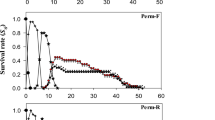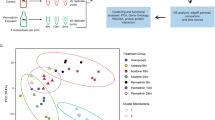Abstract
Assessment of potential health risks to flight attendants from exposure to pyrethroid insecticides, used for aircraft disinsection, is limited because of (a) lack of information on exposures to these insecticides, and (b) lack of tools for linking these exposures to biomarker data. We developed and evaluated a physiologically based pharmacokinetic (PBPK) model to assess the exposure of flight attendants to the pyrethroid insecticide permethrin attributable to aircraft disinsection. The permethrin PBPK model was developed by adapting previous models for pyrethroids, and was parameterized using currently available metabolic parameters for permethrin. The human permethrin model was first evaluated with data from published human studies. Then, it was used to estimate urinary metabolite concentrations of permethrin in flight attendants who worked in aircrafts, which underwent residual and pre-flight spray treatments. The human model was also applied to analyze the toxicokinetics following permethrin exposures attributable to other aircraft disinsection scenarios. Predicted levels of urinary 3-phenoxybenzoic acid (3-PBA), a metabolite of permethrin, following residual disinsection treatment were comparable to the measurements made for flight attendants. Simulations showed that the median contributions of the dermal, oral and inhalation routes to permethrin exposure in flight attendants were 83.5%, 16.1% and 0.4% under residual treatment scenario, respectively, and were 5.3%, 5.0% and 89.7% under pre-flight spray scenario, respectively. The PBPK model provides the capability to simulate the toxicokinetic profiles of permethrin, and can be used in the studies on human exposure to permethrin.
This is a preview of subscription content, access via your institution
Access options
Subscribe to this journal
Receive 6 print issues and online access
$259.00 per year
only $43.17 per issue
Buy this article
- Purchase on SpringerLink
- Instant access to full article PDF
Prices may be subject to local taxes which are calculated during checkout







Similar content being viewed by others
References
Casida JE, Quistad GB . Golden age of insecticide research: past, present and future. Ann Rev Entomol 1998; 43: 1–16.
Berger-Preiss E, Koch W, Behnke W, Gerling S, Kock H, Elflein L et al In-flight spraying in aircrafts: determination of the exposure scenario. Int J Hyg Environ Heal 2004; 207: 419–430.
Berger-Preiss E, Koch W, Gerling S, Kock H, Klasen J, Hoffmann G et al Aircraft disinsection: exposure assessment and evaluation of a new pre-embarkation method. Int J Hyg Environ Health 2006; 209: 41–56.
Spicer CW, Murphy MJ, Holdren MW, Myers JD, MacGregor IC, Holloman C et al Relate Air Quality and Other Factors to Comfort and Health Symptoms Reported by Passengers and Crew on Commercial Transport Aircraft (Part I), Battelle Science and Technology International Columbus, OH. Amercian Society for Heating, Refrigerating, and Air Conditioning Engineers. Atlanta, GA, USA. 2004.
Wei B, Mohan KR, Weisel CP . Exposure of flight attendants to pyrethroid insecticides on commercial flights: urinary metabolite levels and implications. Int J Hyg Environ Health 2012; 215: 465–473.
AQIS/MAFBNZ Schedule of Aircraft Disinsection Procedures 2010 available at: http://www.daff.gov.au/aqis/avm/aircraft/disinsection/procedures (accessed on 21 February 2013).
Narahashi T . Neurophysiological effects of insecticides. In: Krieger R, Doull J, Ecobichon D, (eds). Handbook of Pesticide Toxicology vol. 1 Principles Academic Press: San Diego, CA, USA. 2001 pp 335–350.
Soderlund DM, Clark JM, Sheets LP, Mullin LS, Piccirillo VJ, Sargent D et al Mechanisms of pyrethroid neurotoxicity: implications for cumulative risk assessment. Toxicology 2002; 171: 3–59.
Clark JM, Symington SB . Pyrethroid action on calcium channels: neurotoxicological implications. Invert Neurosci 2007; 7: 3–16.
Ray DE, Fry JR . A reassessment of the neurotoxicity of pyrethroid insecticides. Pharmacol Ther 2006; 111: 174–193.
Bjorling-Poulsen M, Andersen HR, Grandjean P . Potential developmental neurotoxicity of pesticides used in Europe. Environ Health 2008; 7: 50.
DeMicco A, Cooper KR, Richardson JR, White LA . Developmental neurotoxicity of pyrethroid insecticides in zebrafish embryos. Toxicol Sci 2010; 113: 177–186.
Shafer TJ, Meyer DA, Crofton KM . Developmental neurotoxicity of pyrethroid insecticides: critical review and future research needs. Environ Health Perspect 2005; 113: 123–136.
Repetto R, Baliga SS . Pesticides and immunosuppression: the risks to public health. Health Policy Plan 1997; 12: 97–106.
Chen HY, Xiao JG, Hu G, Zhou JW, Xiao H, Wang XR . Estrogenicity of organophosphorus and pyrethroid pesticides. J Toxicol Environ Health A 2002; 65: 1419–1435.
Kakko I, Toimela T, Tahti H . The toxicity of pyrethroid compounds in neural cell cultures studied with total ATP, mitochondrial enzyme activity and microscopic photographing. Environ Toxicol Pharmacol 2004; 15: 95–102.
Kim IY, Shin JH, Kim HS, Lee SJ, Kang IH, Kim TS et al Assessing estrogenic activity of pyrethroid insecticides using in vitro combination assays. J Reprod Dev 2004; 50: 245–255.
US EPA (US Environmental Protection Agency. EPA Pesticide Regulation Notice 96-3. US EPA Office of Pesticide Programs: Washington, DC, USA. 1996 available at: http://www.epa.gov/PR_Notices/pr96-3.html.
AbouDonia MB, Wilmarth KR, Jensen KF, Oehme FW, Kurt TL . Neurotoxicity resulting from coexposure to pyridostigmine bromide, DEET, and permethrin: implications of Gulf War chemical exposures. J Toxicol Environ Health 1996; 48: 35–56.
Bradberry SM, Cage SA, Proudfoot AT, Vale JA . Poisoning due to pyrethroids. Toxicol Rev 2005; 24: 93–106.
Crawford MJ, Croucher A, Hutson D . Metabolism of cis- and trans-cypermethrin in rats. Balance and tissue retention study. J Agric Food Chem 1981; 29: 130–135.
Crawford MJ, Croucher A, Hutson DH . The metabolism of the pyrethroid insecticide cypermethrin in rats; excreted metabolites. Pesticide Sci 1981; 12: 399–411.
Mirfazaelian A, Kim KB, Anand SS, Kim HJ, Tornero-Velez R, Bruckner JV et al Development of a physiologically based pharmacokinetic model for deltamethrin in the adult male Sprague–Dawley rat. Toxicol Sci 2006; 93: 432–442.
Eadsforth CV, Bragt PC, Vansittert NJ . Human dose-excretion studies with pyrethroid insecticides cypermethrin and alphacypermethrin — relevance for biological monitoring. Xenobiotica 1988; 18: 603–614.
Bosch A Metabolism of 14C-deltamethrin in rats. Unpublished report No. 187108 from Hazleton Laboratories America, Madison, WI, USA, AgrEvo document A70824. Submitted to WHO by Hoechst Schering AgrEvo, Frankfurt-am-Main, Germany (GLP) 1990.
Ruzo LO, Unai T, Casida JE . Decamethrin metabolism in rats. J Agric Food Chem 1978; 26: 918–925.
Woollen BH, Marsh JR, Laird WJD, Lesser JE . The metabolism of cypermethrin in man — differences in urinary metabolite profiles following oral and dermal administration. Xenobiotica 1992; 22: 983–991.
Tomalik-Scharte D, Lazar A, Meins J, Bastian B, Ihrig M, Wachall B et al Dermal absorption of permethrin following topical administration. Eur J Clin Pharmacol 2005; 61: 399–404.
Leng G, Gries W, Selim S . Biomarker of pyrethrum exposure. Toxicol Lett 2006; 162: 195–201.
Leng G, Kuhn KH, Idel H . Biological monitoring of pyrethroids in blood and pyrethroid metabolites in urine: applications and limitations. Sci Total Environ 1997; 199: 173–181.
Andersen ME . Toxicokinetic modeling and its applications in chemical risk assessment. Toxicol Lett 2003; 138: 9–27.
Beaudouin R, Micallef S, Brochot C . A stochastic whole-body physiologically based pharmacokinetic model to assess the impact of inter-individual variability on tissue dosimetry over the human lifespan. Regul Toxicol Pharmacol 2010; 57: 103–116.
Chiu WA, Barton HA, Dewoskin RS, Schlosser P, Thompson CM, Sonawane B et al Evaluation of physiologically based pharmacokinetic models for use in risk assessment. J Appl Toxicol 2007; 27: 218–237.
Clewell HJ, Gentry PR, Covington TR, Sarangapani R, Teeguarden JG . Evaluation of the potential impact of age- and gender-specific pharmacokinetic differences on tissue dosimetry. Toxicol Sci 2004; 79: 381–393.
Haddad S, Beliveau M, Tardif R, Krishnan K . A PBPK modeling-based approach to account for interactions in the health risk assessment of chemical mixtures. Toxicol Sci 2001; 63: 125–131.
Mörk AK, Johanson G . Chemical-specific adjustment factors for intraspecies variability of acetone toxicokinetics using a probabilistic approach. Toxicol Sci 2010; 116: 336–348.
Valcke M, Krishnan K . Evaluation of the impact of the exposure route on the human kinetic adjustment factor. Regul Toxicol Pharmacol 2011; 59: 258–269.
Godin SJ, DeVito MJ, Hughes MF, Ross DG, Scollon EJ, Starr JM et al Physiologically based pharmacokinetic modeling of deltamethrin: development of a rat and human diffusion-limited model. Toxicol Sci 2010; 15: 330–343.
US EPA (US Environmental Protection Agency) Assessing Approaches for the Development of PBPK Models of Pyrethroid Pesticides US EPA Office of Pesticide Programs: Washington, DC, USA. 2007.
Tornero-Velez R, Mirfazaelian A, Kim KB, Anand SS, Haines WT, Bruckner JV et al Evaluation of deltamethrin kinetics and dosimetry using an PBPK model. Toxicol Appl Pharmacol 2010; 244: 208–217.
Hughes MF, Edwards BC . In vitro dermal absorption of pyrethroid pesticides in human and rat skin. Toxicol Appl Pharmacol 2010; 246: 29–37.
Reifenrath WG, Ross JH, Driver JH . Experimental methods for determining permethrin dermal absorption. J Toxicol Environ Health A 2011; 74: 325–335.
Scollon EJ, Starr JM, Godin SJ, DeVito MJ, Hughes MF . In vitro metabolism of pyrethroid pesticides by rat and human hepatic microsomes and cytochrome P450 isoforms. Drug Metab Dispos 2009; 37: 221–228.
Mason RO, Lind DA, Marchal WG . Statistics: An Introduction. Harcourt Brace Jovanovich: New York, NY, USA. 1983 pp 368–383.
Weber JC, Lamb DR . Statistics and Research in Physical Education. Mosby: St Louis, MO, USA. 1970 pp 59–64 222.
Tan YM, Liao KH, Conolly RB, Blount BC, Mason AM, Clewell HJ . Use of a physiologically based pharmacokinetic model to identify exposures consistent with human bio-monitoring data for chloroform. J Toxicol Environ Health A 2006; 69: 1727–1756.
Clewell HJ, Gearhart JM, Gentry PR, Covington TR, VanLandingham CB, Crump KS et al Evaluation of the uncertainty in an oral reference dose for methylmercury due to interindividual variability in pharmacokinetics. Risk Anal 1999; 19: 547–558.
US EPA (Environmental Protection Agency). Exposure Factors Handbook (Final Report) 1997 available at: http://cfpub.epa.gov/ncea/cfm/recordisplay.cfm?deid=12464 (accessed on 21 February 2013).
Timchalk C, Nolan RJ, Mendrala AL, Dittenber DA, Brzak KA, Mattsson JL . A physiologically based pharmacokinetic and pharmacodynamic (PBPK/PD) model for the organophosphate insecticide chlorpyrifos in rats and humans. Toxicol Sci 2002; 66: 34–53.
Clewell HJ, Gentry PR, Covington TR, Gearhart JM . Development of a physiologically based pharmacokinetic model of trichloroethylene and its metabolites for use in risk assessment. Environ Health Perspect 2000; 108 (Suppl 2): 283–305.
Corley RA, Gordon SM, Wallace LA . Physiologically based pharmacokinetic modeling of the temperature-dependent dermal absorption of chloroform by humans following bath water exposures. Toxicol Sci 2000; 53: 13–23.
Keenan JJ, Vega H, Krieger RI . Potential exposure of children and adults to cypermethrin following use of indoor insecticide foggers. J Environ Sci Health Part B 2009; 44: 538–545.
Williams RL, Bernard CE, Krieger RI . Human exposure to indoor residential cyfluthrin residues during a structured activity program. J Expo Anal Environ Epidemiol 2003; 13: 112–119.
Acknowledgements
The research reported in this study was funded by the US Federal Aviation Administration (FAA) Office of Aerospace Medicine through the National Air Transportation Center of Excellence for Research in the Intermodal Transport Environment, Aircraft Cabin Environment Research (ACER) under Cooperative Agreement 07-C-RITE-UMDNJ. Although the FAA has sponsored this project, it neither endorses nor rejects the findings of this research. This research was supported in part by the NIEHS sponsored Center for Environmental Exposure and Disease, Grant No. P30ES005022.
Author information
Authors and Affiliations
Corresponding author
Ethics declarations
Competing interests
The authors declare no conflict of interest.
APPENDIX I
APPENDIX I
PBPK MODEL EQUATIONS
- Q c :
-
cardiac output (l/h)
- Q p :
-
alveolar ventilation rate (l/h)
- C vt :
-
the tissue venous blood concentration (mg/l)
- AV i :
-
venous amount in organ i
- V i :
-
Volume of compartment i
- A i :
-
amount of permethrin in the compartment i
- Q i :
-
blood flow to the compartment i
- P i: b :
-
tissue:blood partition coefficient for the compartment i
- C i :
-
concentrations in the compartment i
- PVF i :
-
blood volume fraction of compartment i
- PA i :
-
permeability–surface area product of tissue (l/h)
- Inhale_Conc :
-
inhaled airborne concentration of permethrin (mg/l)
- M BLD :
-
amount of permethrin in blood (mg/h)
- CA :
-
concentration in blood compartment (mg/l)
- VB :
-
blood volume
- ODRate :
-
oral dose rate (mg/h)
- Stomach :
-
amount of permethrin in stomach (mg)
- Intestine :
-
amount of permethrin in intestine (mg)
- K s :
-
rate constant of absorption from stomach (h−1)
- K i :
-
rate constant of absorption from intestine (h−1)
- K si :
-
rate constant of transfer from stomach to intestine (h−1)
- K fec :
-
fecal excretion rate constant (h−1).
- A skin :
-
amount of permethrin in the skin compartment
- Q skin :
-
blood flow to the skin compartment
- P skin:b :
-
skin compartment:blood partition coefficient
- C skin :
-
concentrations in skin compartment
- derm_rate :
-
dose rate from dermal absorption
- SL :
-
surface loading of permethrin (μg/cm2)
- SA :
-
body surface area in direct contact with surface (cm2)
- TF :
-
transferable surface residue of permethrin to exposed dermal
- CABF :
-
cumulative absorbed dose fraction (%)
- exp_time :
-
exposure duration (h).
- met :
-
amount of metabolized permethrin in excretion compartment (mg)
- RAM liver :
-
rate of metabolism in liver (mg/h)
- RAM BLD :
-
rate of clearance in blood (mg/h)
- RAM i :
-
rate of metabolism from compartment i (mg/h)
- M BLD :
-
amount of permethrin in blood (mg)
-
 :
: -
amount of excreted permethrin through urine (mg)
- K ur :
-
urinary excretion rate constant (h−1)
Model Equations
Rate of change in stomach (mg/h):

Rate of change in intestine (mg/h):

Rate of change in blood (mg/h):

Rate of clearance in blood (mg/h):

Permethrin concentration in blood (mg/l):

Distribution in flow-limited tissues (except liver and skin compartments):

Rate of change in liver compartment:

Rate of change in skin compartment:

Dermal absorption rate estimation:

Distribution in diffusion-limited tissues (fat, brain and slow perfused tissues):


Rate of change estimation for metabolized permethrin in excretion compartment (mg/h):

Excretion of metabolized permethrin through urine:

Urinary concentration:

where Conc is the urinary concentration for a specific metabolite of permethrin.  is the cumulative mass of permethrin metabolite during two excretion time points (mg).
is the cumulative mass of permethrin metabolite during two excretion time points (mg).  is the cumulative urine volume at the same duration (l). As for flight attendants, the time duration from the last excretion time to the sampling time point was in the range from 1to 4 h, and the corresponding urine volume was in the range from 0.03 to 0.75 l.
is the cumulative urine volume at the same duration (l). As for flight attendants, the time duration from the last excretion time to the sampling time point was in the range from 1to 4 h, and the corresponding urine volume was in the range from 0.03 to 0.75 l.
Rights and permissions
About this article
Cite this article
Wei, B., Isukapalli, S. & Weisel, C. Studying permethrin exposure in flight attendants using a physiologically based pharmacokinetic model. J Expo Sci Environ Epidemiol 23, 416–427 (2013). https://doi.org/10.1038/jes.2013.12
Received:
Accepted:
Published:
Issue date:
DOI: https://doi.org/10.1038/jes.2013.12
Keywords
This article is cited by
-
Impact of gulf war toxic exposures after mild traumatic brain injury
Acta Neuropathologica Communications (2022)
-
Assessing exposure to tobacco-specific carcinogen NNK using its urinary metabolite NNAL measured in US population: 2011–2012
Journal of Exposure Science & Environmental Epidemiology (2016)




 :
: